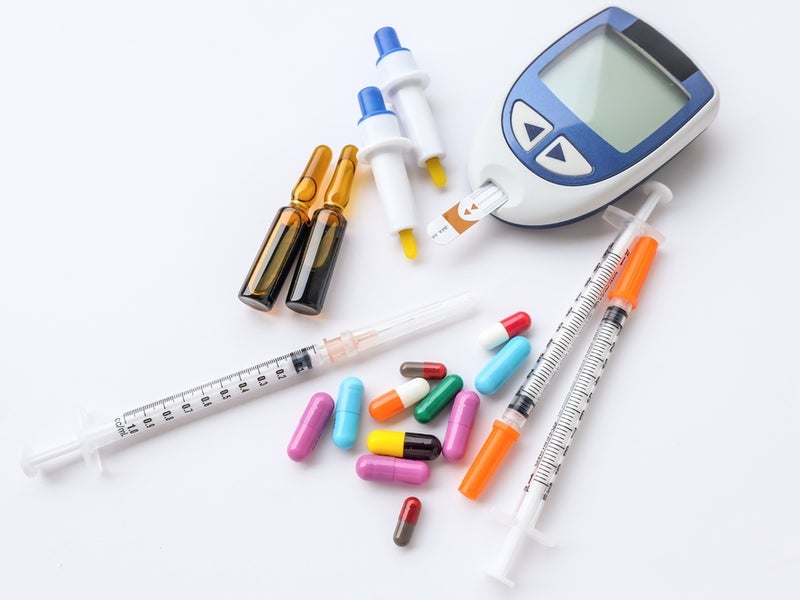
As the prevalence of type 1 and 2 diabetes continues to rise across the globe – the US is on course to reach more than 68 million diabetics in the coming years – the need for effective and accessible monitoring technologies is growing in step. Diabetics need to constantly monitor their blood sugar levels, as they can no longer self-regulate, and must administer their own insulin – although a lot of type 2 diabetics can manage their condition through eating well and moving more.
Traditionally, this is done through a finger-prick test. While this can tell a patient whether their blood sugar is high or low, it will not tell them whether it is rising or dropping.
While initial symptoms of diabetes can often be overlooked for years, the percentage of diabetics who are getting diagnosed is increasing: GlobalData estimates that by 2025, over 90% of diabetics will be diagnosed in the US. This opens up the market for improved blood sugar testing devices such as continuous glucose monitors (CGMs).
A CGM can supply blood sugar readings at regular intervals throughout the day, meaning patients can see whether their blood sugar levels are rising or dropping and plan accordingly.
A more convenient way to monitor
The device consists of a glucose sensor inserted under the skin which continuously tracks insulin levels from interstitial fluid, a thin layer of fluid surrounding the body’s cells. The CGM software then transmits the signal from the sensor into a blood sugar reading on a receiver for the user. The technology has now come so far that this receiver can even be a mobile phone in certain models.
Interstitial fluid sugar readings are a few minutes behind actual blood sugar levels.
How well do you really know your competitors?
Access the most comprehensive Company Profiles on the market, powered by GlobalData. Save hours of research. Gain competitive edge.

Thank you!
Your download email will arrive shortly
Not ready to buy yet? Download a free sample
We are confident about the unique quality of our Company Profiles. However, we want you to make the most beneficial decision for your business, so we offer a free sample that you can download by submitting the below form
By GlobalDataHowever, the US Food and Drug Administration (FDA) has recently had to warn patients and healthcare providers about the dangers of various devices for diabetes management. This includes CGMs, as well as insulin pumps and automated insulin dosing systems.
This is because some diabetic patients have been building their own artificial pancreas systems to help control blood sugar levels.
The do-it-yourself devices connect CGMs to insulin pumps using computer algorithms, working in a cycle of testing blood sugar and infusing insulin. This is supposed to reduce the effort required from a patient to manage their condition.
The practice has led to one woman requiring medical intervention after an accidental insulin overdose. This can lead to severe low blood sugar, coma, diabetic ketoacidosis and even death.
Unauthorised devices are causing damage
The patient in question had used an unauthorised insulin pump, which was synced up to receive a signal from an authorised CGM. However, while the CGM itself was FDA-authorised, the algorithm it was using to convert the data it collected from the woman’s interstitial fluid into a glucose value to be dispensed by the pump was unauthorised. The automated insulin dosing system gave too much insulin in response to repeated incorrect high glucose values sent from the CGM, resulting in an overdose.
It is unclear whether the overdose resulted from inaccurate glucose readings from the unauthorised algorithm or a software malfunction.
“These devices were not designed to be used together and were combined in a way that had not been thoroughly tested for compatibility,” the agency said. “Patient use of unauthorized diabetes management devices, alone or along with other devices, could result in inaccurate glucose level readings or unsafe insulin dosing.”
The FDA does endorse certain artificial pancreas systems. However, these will all include a specific CGM, pump and algorithm, and will have been tested and authorised together as a system.
This case of accidental overdose is symptomatic of the lengths to which patients will go and the risks they will take to minimise the impact of their chronic condition on their everyday life, both in terms of lifestyle and finances. As diabetes diagnoses rise, it will only become more pressing for medical device manufacturers to develop safe, affordable and reliable autonomous insulin systems that don’t risk sending patients into a coma.



